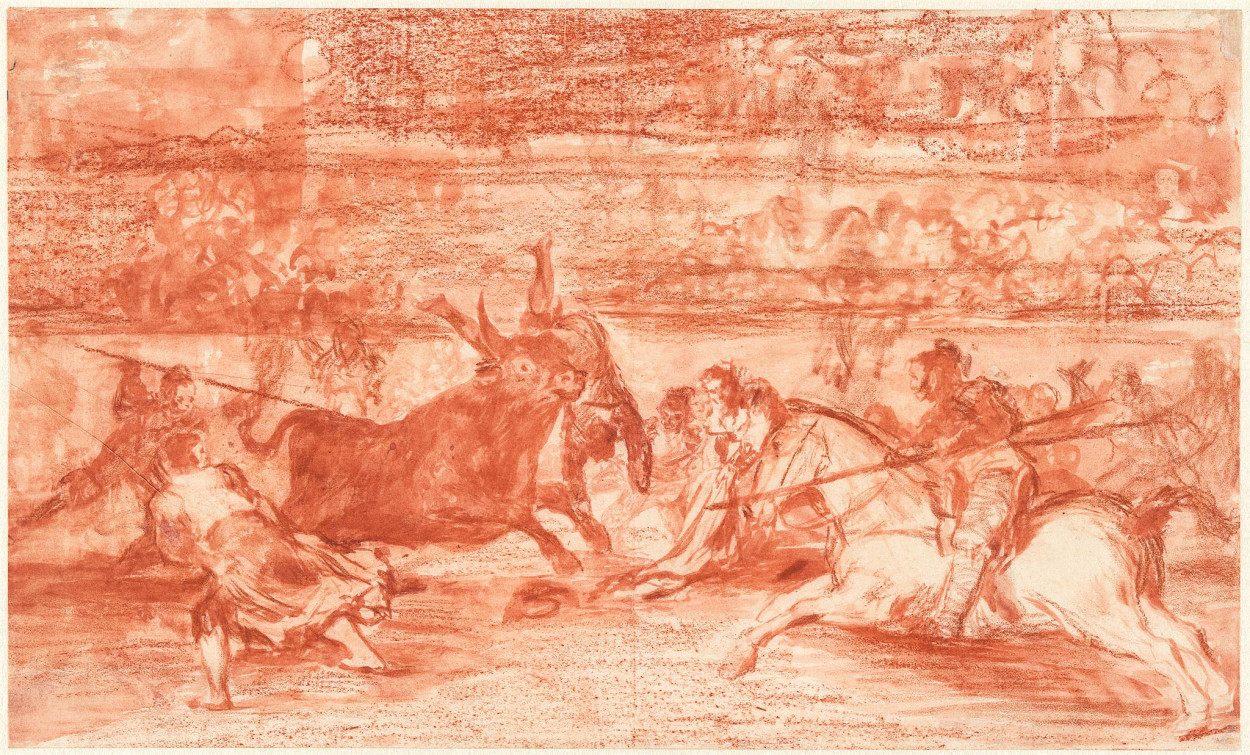
Francisco José de Goya y Lucientes, Zeichner
Der Tod des Pepe Illo - 1. Variante - Vorzeichnung zur "Tauromaquia", Platte E auf der Rückseite von Platte 1, 1814 - 1816
This drawing includes many of the characteristics present in all of Francisco de Goya's preparatory sketches for the Tauromaquia: a precise definition of the main figures; an abbreviated and subtle representation of secondary figures, the public and those in the burladero;[1]* and the same overall approach to light and shadows. However, the combination of red chalk and red-ink wash with a looser technique appears only here and in preparatory drawings for print numbers 27 (Madrid, Museo Nacional del Prado, D 4314), 32, and K (both in Hamburg, Hamburger Kunsthalle, inv. nos. 38541 and 38542, cat. nos. 64 and 66). For the rest, Goya used only red chalk. This, and the fact that their provenance is different than those in the Museo del Prado, may be what led Enrique Lafuente Ferrari to question the authenticity of the Hamburg preparatory sketches.[2] Judging by the photographic reproduction published by Loys Delteil,[3] Lafuente Ferrari characterized the present drawing as "a not especially fine imitation."[4] In fact, this work is absolutely identifiable with the rest in its style, technique, and paper. Moreover, as occurs in other cases, despite some differences, the print does contain initial strokes that reflect those of the drawing, suggesting that the latter was first transferred to the copper plate, and only then modified. Here, a close observation of the print reveals that the horse's hooves were originally more extended, just as they appear in the drawing. This ratifies Goya's technique, which involved transferring the drawing to the plate and then going over the main lines of the composition before directly modifying whatever he considered necessary.
This drawing relates to one of the compositions not included in the final series, Tauromaquia E, which appears on the back of the plate bearing the composition for Tauromaquia 11 and can be found in the fourth edition, published in Paris by Eugène Loizelet in 1876 as "E. Mort de Pepelllo (2e composition)." Searching for literary sources related to the prints, Lafuente Ferrari[5] was the first to associate this composition with a text by José de la Tixera[6] that describes how the bull “flinging his body around in different positions, held him for over a minute," while picador Juan López attempted to distract him by "trying to impale him from his rearing horse."
José Manuel Matilla
1 * Trans. Note: The burladeros are small sections of the bullring's barrier that jut out into the arena itself. They allow the bullfighter's assistants rapid lateral access to the ring to assist him, or to tease (burlarse de) the bull.
2 Lafuente Ferrari 1941, 186.
3 Delteil 1922, no. 261.
4 See Lafuente Ferrari 1941.
5 Lafuente Ferrari 1946, 211-12.
6 Copia de carta en que un amigo refiere a otro con exactitud el hecho (con sus antecedentes y conseqüentes) relativo a la muerte del memorable lidiador Joseph Delgado, renombrado Hillo, causada por el séptimo toro de los corridos en la Plaza de Madrid la tarde del 11 de Mayo de 1801.(Copy of a letter in which a friend recounts to another with exactitude the events (with its antecedents and consequences surrounding the death of the memorable bullfighter Joseph Delgado, known as Hillo, caused by the seventh bull to appear at the Plaza de Madrid on the eve of May 11, 1801), Barcelona, Libreria de Sastre, 1801.
